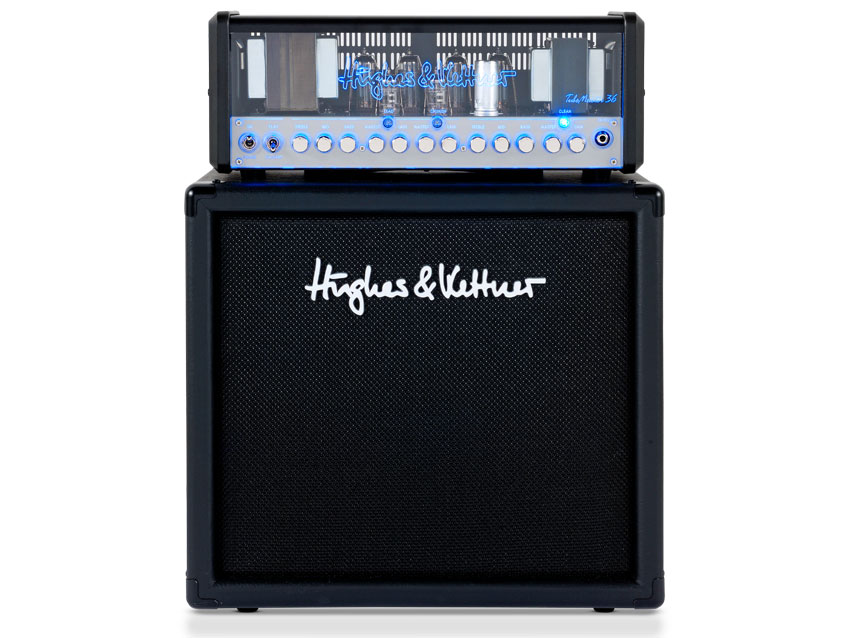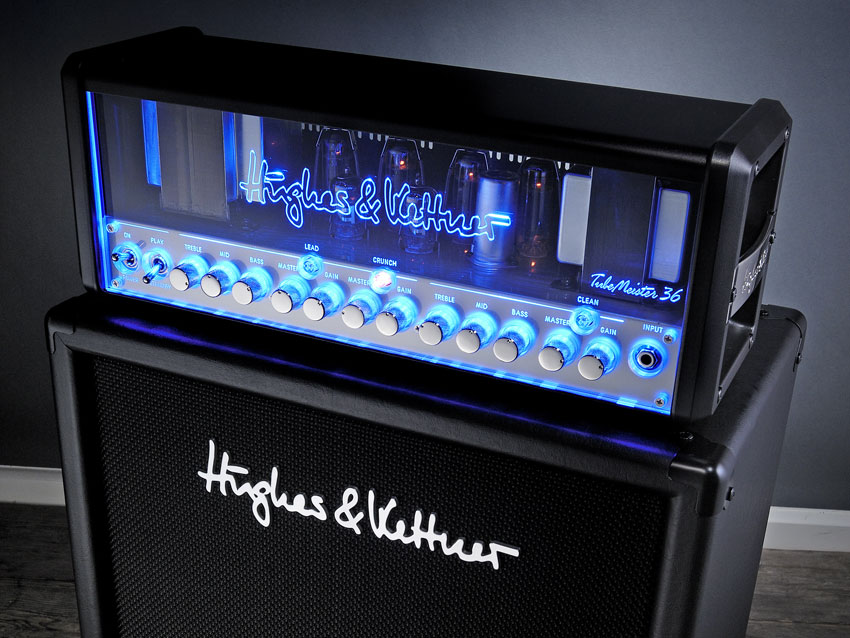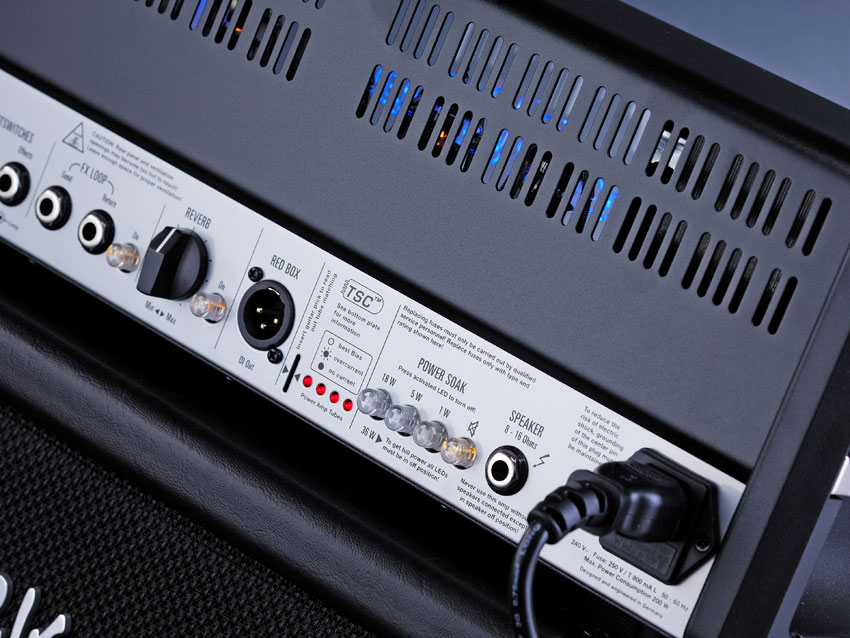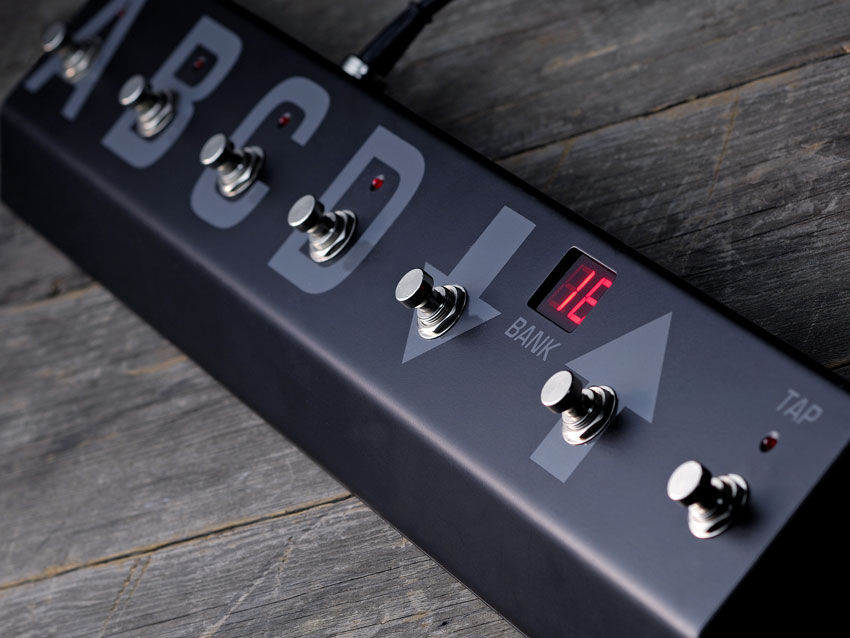MusicRadar Verdict
Hughes & Kettner has produced a gem we reckon will sell and sell.
Pros
- +
Boutique-quality tone, features and looks at a very reasonable price.
Cons
- -
Apart from a lack of MIDI out socket, there's not much to complain about.
MusicRadar's got your back

Hughes & Kettner TubeMeister 36

Hughes & Kettner TubeMeister 36 (controls)

Hughes & Kettner TubeMeister 36 (rear)

Hughes & Kettner FSM-432 MIDI controller (£120)
The so-called 'lunchbox' head has definitely been one of the biggest amplification stories around the world for the last five years or so, with many amplifier manufacturers adding a metal-bodied, small to medium-powered head to their catalogues.
Hughes & Kettner may have come late to the game, but its German-designed and Chinese-built TubeMeister range has been one of the success stories of the last year, generating significant positive publicity across the real and virtual worlds. We've already looked at the five-watt and 18-watt versions, now it's time to ogle the amp that threatens to fire a howitzer into the mid-priced head market - the TubeMeister 36.
The most significant upgrade over the TM18 is the MIDI-in socket. All of the TubeMeister 36's switched functions can be operated via MIDI, including the power soak
The TubeMeister 36 shares the same design format as its two smaller siblings with a robust steel chassis supporting two oversized transformers, four EL84 output valves and three 12AX7 preamp valves. Inside there are two main circuit boards: one holds all the valve bases and most of the amp circuitry, the second accommodates most of the rear panel equipment.
There are a couple of smaller PCBs that appear to hold the MIDI and digital effects stuff. The quality is typical of Hughes & Kettner's high standard; all the boards are through-plated and they're stuffed with high temperature electrolytic capacitors and close tolerance metal film resistors for durability, consistency and low noise.
The chrome front panel features the Hughes & Kettner hallmark-engraved clear Perspex fascia, which lights up in blue when the power goes on. Previously reserved for top-flight models such as the Triamp and Puretone, this either looks unbelievably cool, or not, depending on your taste. But coupled with the TubeMeister 1 x 12 enclosure, the head looks like it means business while also being small enough not to dominate a lounge or bedroom.
Further building upon the TubeMeister 18's features, the 36-watt version offers three channels for clean, crunch and lead, each with separate gain and master volume controls. There are two three-band EQs - one for the clean channel, the other shared by crunch and lead.
Around the back, you'll find a series of pushbutton switches for the TubeMeister's built-in attenuator that progressively reduce output power from 36 watts down to 18, five, or one watt, with a mute switch. This disconnects the speaker but leaves the head's built-in Red Box speaker emulator on for silent recording.
There's also a switchable series effects loop, digital reverb, and Hughes & Kettner's clever TSC (Tube Safety Control), which constantly monitors and micro-adjusts bias to ensure the amp is running at peak efficiency. In addition, a single speaker outlet and a pair of footswitch jacks operate channel-switching, reverb and loop functions.
However, the most significant upgrade over the TM18 is the MIDI-in socket. All of the TubeMeister 36's switched functions can be operated via MIDI, including the power soak. The significance of that is immense because you can seamlessly go from a fat clean sound using all 36 watts for maximum headroom, through a slightly compressed crunch tone on 18 watts, to a fully saturated lead sound with the master cranked up on five watts, or any combination.
The Red Box speaker emulator offers a balanced output for easy connection to PA or recording equipment. There's no ground-lift switch, which would have been the hundreds and thousands on top of an already well-iced cake, but it's not a major inconvenience. Another slight disappointment is the lack of a MIDI out/thru socket, which means the TM36 can only accept incoming MIDI patch change commands.
All in, the TubeMeister is every bit as good on the inside as it is on the outside. It may originate from China, but it's built to the same high standard that we've come to expect from all Hughes & Kettner products and should easily handle the rigours of non-stop gigging without any complaint.
Sounds
Using a variety of different guitars to test the TubeMeister 36, including our regular test-bed Strat, a Gibson Les Paul Standard with PAF humbuckers and a nicely yellowed 1970 Les Paul Custom, we found this head can sound as vintage or as modern as you like, with a definite American influence on the clean and crunch tones, while the lead channel is more in British territory, with a hint of another famous EL84-powered amp.
Being able to switch everything simultaneously using MIDI kicks the TubeMeister 36 into a different league
The clean channel is open and airy, with clarity that's almost hi-fi at lower gain settings and sounds superb with a dash of chorus. With the gain turned up, the clean channel starts to growl a little - more so if you reduce the amp's power output and turn up the channel volume.
Swap for humbuckers and there's plenty of drive available to turn the clean channel into a second crunch channel. This overlaps nicely with the real crunch channel, which adds a good deal more overdrive and aggression, with plenty of bottom end from the dual-ported 1 x 12 cabinet. This Vintage 30-powered enclosure is very impressive; made from decent quality plywood, it sounds a lot bigger than it looks.
The lead channel adds even more gain for a singing overdrive with just the right amount of edge to add bite to dark guitars. On some other Hughes & Kettner amps, you need to work a bit to find your sound. However, on the TubeMeister it's already there waiting for you - just a little fine-tuning from the smoothly interacting bass, mid and treble controls is all that's needed.
The digital reverb sounds like it emulates a spring and works well for more pronounced effects as well as background ambience. The internal Red Box sounds good into a desk with minimal need for EQ.
It's all good stuff, but being able to switch everything simultaneously using MIDI really kicks the TubeMeister 36 into a different league. We hooked it up to a BOSS GT-10 effects processor and in just a few minutes, the TubeMeister was automatically changing channels, power soak settings and reverb, as we swapped patches on the BOSS.
We reckon the TubeMeister 36 will tick all the boxes for many potential customers. There really isn't much to criticise: we mentioned the lack of a MIDI out/thru socket earlier, the only other thing that we're not sure about is the way Hughes & Kettner has shared the TubeMeister 36's two EQs between three channels.
We think the lead channel would be more versatile with its own dedicated network, and the clean and crunch channels sharing the other EQ. But it's not a major issue, as all three channels have excellent response and sound superb right out of the box.
Just as well, because there are some hot competitors in the tone department at the moment. However, none have MIDI switching and a multi-step attenuator that can also be remotely controlled - we think that's a first and it makes the TubeMeister 36 a seriously versatile amp, especially when teamed with a good MIDI effects device.
If you're looking for a mid-priced amp that really can do it all, the TubeMeister 36 deserves to be right at the top of your 'must try' list.
“A synthesizer that is both easy to use and fun to play whilst maintaining a decent degree of programming depth and flexibility”: PWM Mantis review
“I feel like that song had everything we needed to come back with”: Bring Me The Horizon’s Lee Malia on Shadow Moses, its riff and the secrets behind its tone, and why it was the right anthem at the right time
“I said, ‘Are we sure we can write a song about death?’”: The story of Mike + The Mechanics' classic No.1 The Living Years









